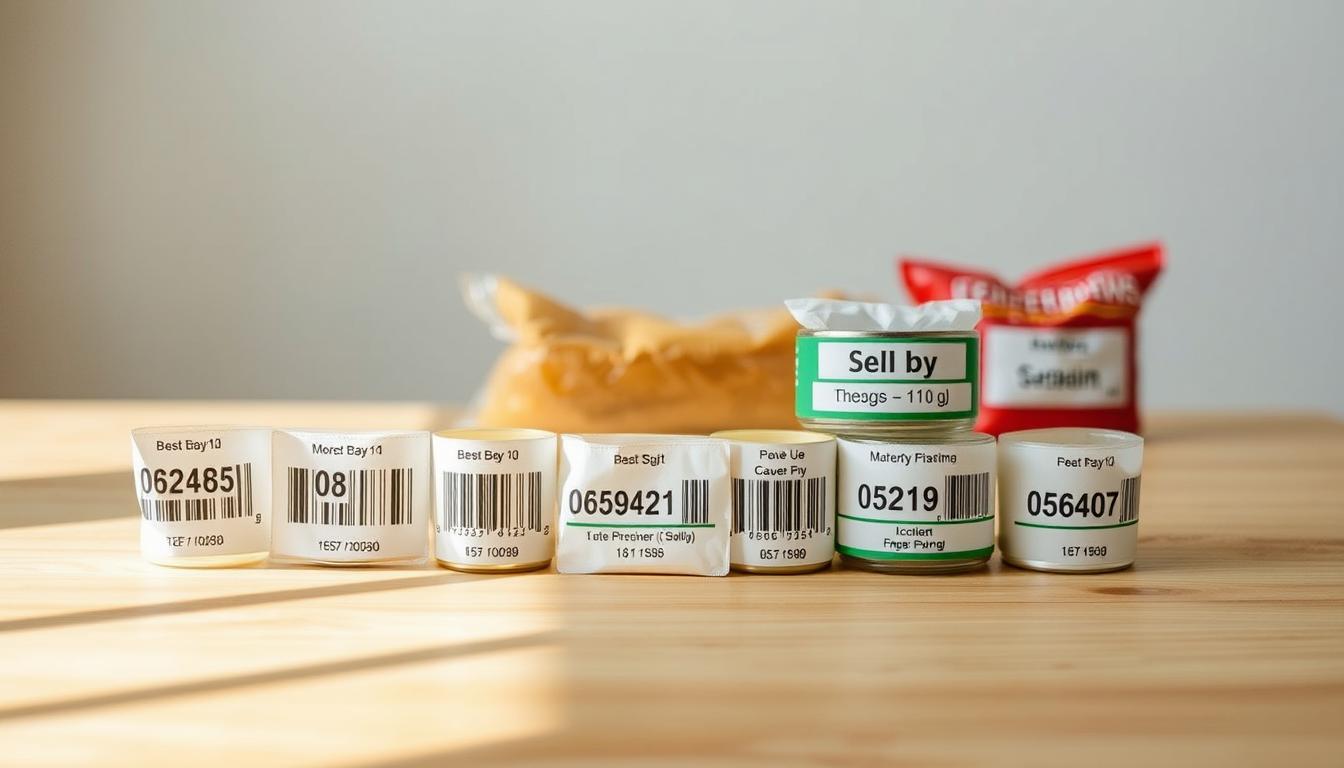Did you know 90% of Americans throw away perfectly edible food because they misunderstand package dates? Those numbers on your milk carton or canned goods aren’t what you think. Unlike medication expiration rules, U.S. food dating lacks federal standardization, creating a maze of conflicting guidelines.
Modern date labeling began in the 1950s as stock rotation codes for supermarkets. Manufacturers used them to track inventory freshness—not consumer safety. Today, phrases like “best by” or “use before” remain unregulated, with criteria varying wildly between brands and states.
Food producers determine dates using factors like packaging technology and ideal storage conditions. A bag of chips might get a 9-month quality window based on when taste tests show staleness begins. Refrigerated items get shorter timelines due to temperature sensitivity.
Key Takeaways
- Date labels originated as grocery store inventory tools, not safety guides
- No federal rules exist for food dating standards in the U.S.
- Manufacturers set dates based on quality, not contamination risks
- Storage conditions dramatically affect actual product freshness
- Confusing labels contribute to 20% of household food waste
This patchwork system leaves many guessing whether that yogurt is unsafe or just less creamy. While 30 states have partial regulations, most dates reflect peak quality rather than true expiration. Learning to decode these labels could save your wallet—and reduce unnecessary waste.
Introduction to Food Dating and Labeling
Those numbers stamped on packaging aren’t expiration codes—they’re quality markers created by manufacturers. Food producers use two main dating methods to communicate freshness timelines:

Visible Dates vs Hidden Codes
Perishable items like eggs and milk use open dating with clear month/day/year formats. This helps consumers identify newer stock quickly. Shelf-stable goods often feature closed coding—symbols only staff can decipher for inventory tracking.
| Dating Type | Common Products | Consumer Visibility |
|---|---|---|
| Open Dating | Dairy, meats, bread | Full calendar date shown |
| Closed Coding | Canned goods, dry pasta | Manufacturer codes only |
| Hybrid Systems | Frozen meals, snacks | Date plus batch numbers |
Why Dates Influence Choices
Shops use these labels to rotate stock efficiently. When you reach for yogurt with a later date, you’re participating in this system—even though both containers might stay safe for weeks. Manufacturers determine dates through taste tests and packaging research, not safety studies.
Understanding this helps reduce confusion. Proper storage often extends freshness beyond printed dates. Your freezer becomes a time machine for meats, while airtight containers keep cereal crisp past its “best by” mark.
What Do “Sell-By,” “Best-By,” and “Use-By” Dates Mean?
Decoding food package dates requires understanding three key phrases that guide decisions. Unlike expiration codes on medicines, these labels primarily track freshness rather than safety.

Defining the Different Date Terminologies
“Sell-By” dates act as inventory reminders for stores. Retailers use them to rotate stock efficiently—products often stay safe for days or weeks after this marker. For example, milk typically remains fresh 5-7 days past its sell-by date when refrigerated.
“Best if Used By” labels focus on flavor quality. Manufacturers determine these dates through taste tests, not safety checks. Crackers might lose crispness beyond this date but won’t necessarily harm you.
| Label Type | Primary Purpose | Focus | Action Required |
|---|---|---|---|
| Sell-By | Store stock rotation | Retail efficiency | Buy before date |
| Best if Used By | Peak quality guidance | Flavor/texture | Use for optimal taste |
| Use-By | Manufacturer’s freshness endpoint | Quality assurance | Consume by date |
“The ‘use-by’ date represents the last day we guarantee peak quality under ideal storage conditions,” explains a food production specialist.
The Role of Open and Closed Dating Systems
Open dating uses visible dates like “09/15/2024” for perishables. Closed systems apply codes like “L324A1” on canned goods—numbers tracking production batches rather than freshness.
Industry leaders recently standardized labels to reduce confusion. The Consumer Brands Association and Food Marketing Institute now recommend:
- “Best if used by” for quality timelines
- “Use by” for infant formula safety
This initiative helps distinguish between products that decline in taste versus those with potential health risks. Your cereal’s “best by” date? More about crunch than contamination.
The Science of “Sell By” Dates: Quality, Freshness, and Safety
Behind every date label lies a mix of science and guesswork. Food producers use complex calculations to predict when products might lose peak appeal, focusing on flavor changes rather than contamination risks. These timelines vary widely because no federal rules dictate how companies set their markers.

How Manufacturers Determine Date Labels
Large companies often conduct taste tests with focus groups to pinpoint when crackers lose crunch or yogurt separates. Smaller producers might estimate dates based on similar products. Key factors include:
| Factor | Quality Impact | Safety Consideration |
|---|---|---|
| Storage Temperature | Affects flavor & texture | Rarely linked to contamination |
| Packaging Material | Preserves crispness | Prevents spoilage |
| Moisture Content | Influences mold growth | Doesn’t predict foodborne illness |
Packaging technology plays a huge role. Modified atmosphere packaging can triple salad greens’ shelf life by controlling oxygen levels. But these dates still reflect best quality – not when food becomes unsafe.
Scientific Insights Behind Date Labeling
Acidity (pH levels) and preservatives determine how quickly foods degrade. High-moisture items like deli meats get shorter dates due to bacterial growth risks. Dry pasta lasts years because low water activity inhibits microbes.
Despite advanced methods, two identical products from different brands may have wildly different dates. One company’s “use by” could be another’s “best before” – all based on internal quality standards rather than safety protocols.
Food Safety and Handling Guidelines
Your kitchen habits matter more than package dates when preventing foodborne illnesses. Mishandling creates risks long before expiration markers become relevant. Let’s explore how to outsmart invisible threats through smart practices.

Cold Chain Commandments
Keep perishables safe by maintaining refrigerator temperatures at 40°F or below. Bacteria double every 20 minutes in the “danger zone” between 40°F-140°F. Follow these rules:
- Store raw meats on bottom shelves to prevent drips
- Use appliance thermometers – dial settings often lie
- Return groceries to cold storage within 2 hours (1 hour if above 90°F)
Defense Against Invisible Threats
Cross-contamination causes 89% of kitchen-related illnesses. Use separate cutting boards for produce and proteins, and sanitize surfaces after preparing raw items. Thaw frozen foods in refrigerators – never on counters where bacteria thrive.
“Date labels can’t protect against improper handling. Your sandwich meat might be ‘safe’ by the date, but if left unrefrigerated during a power outage, toss it,” advises USDA Food Safety Specialist Laura Johnson.
| Safe Practice | Risky Behavior | Result |
|---|---|---|
| Chilling leftovers quickly | Leaving food to cool overnight | Bacterial takeover |
| Using sealed containers | Covering with foil/cloth | Contamination risk |
| Frequent handwashing | Rinsing without soap | Pathogen spread |
Trust your senses over dates. Foul odors, slimy textures, or unusual colors signal spoilage – nature’s original expiration alerts. When in doubt, throw it out.
Storage Tips for Meat, Dairy, Eggs, and Bread
Proper storage transforms dates from deadlines to guidelines. Keeping foods at ideal temperatures maximizes freshness while reducing waste. Let’s explore how to extend the life of common perishables through smart refrigeration and freezing techniques.

Refrigeration and Freezing Recommendations
Ground meats require extra caution due to increased surface area. Store hamburger or turkey in your refrigerator’s coldest zone for 1-2 days. Freeze portions in airtight packages for 3-4 months. Whole cuts like steaks last 3-5 days chilled or up to a year frozen.
| Protein | Fridge Days | Freezer Months |
|---|---|---|
| Fish fillets | 1-2 | 3-8 |
| Chicken (whole) | 1-2 | 12 |
| Pork chops | 3-5 | 4-12 |
Eggs maintain quality best in their original cartons. Avoid door storage—temperature fluctuations reduce freshness. Refrigerated eggs stay safe for 3-5 weeks, far beyond carton dates.
Dairy products demand consistent cold temperatures:
- Pasteurized milk: 7-14 days at 40°F
- UHT milk: 2 weeks after opening
- Hard cheeses: 3-4 weeks wrapped tightly
Bread defies countertop limits through freezing. Slice before freezing for easy portioning. Frozen loaves retain texture for 2-3 months versus 4 days at room temperature.
Examining Expiration Dates and Consumer Confusion
American households toss more edible food than grocery stores and restaurants combined. This waste stems from widespread misinterpretation of package labels, with 43% of discarded items being perfectly safe to eat. Confusion between quality suggestions and safety warnings drives billions in annual losses.
Why Labels Mislead Shoppers
Most people treat “best by” markers as expiration deadlines. A 2023 study found 68% of consumers discard unopened items once dates pass, fearing illness. This habit persists despite regulators confirming most labels indicate freshness, not safety.
Retail environments amplify confusion. Shoppers gravitate toward products with distant dates, leaving near-code items untouched. Stores discard these “expiring” goods to maintain abundant displays—a practice contributing to 10% of retail waste.
| Consumer Perception | Reality | Result |
|---|---|---|
| “Use by” = Poison date | Peak quality estimate | Premature disposal |
| Full shelves = Freshness | Inventory management | Overstock waste |
| Date passing = Danger | Gradual quality decline | $1,600/year household loss |
“We’ve conditioned people to view dates as binary switches—safe today, toxic tomorrow. That’s not how food works,” notes food waste researcher Dr. Ellen Park.
Improved labeling could slash waste, but education matters more. Learning to assess odors, textures, and storage conditions helps override date anxiety. Your freezer and senses prove better guides than arbitrary numbers.
Impact of Date Misunderstanding on Food Waste and Economy
Every year, misinterpreted date labels drain billions from wallets and landfills alike. Nearly 40% of the U.S. food supply gets tossed while still edible—enough to feed every American household for months. This confusion creates a ripple effect hitting both personal budgets and global ecosystems.
Financial and Environmental Consequences
Households lose $1,500+ annually discarding “expired” items. Nationally, food waste costs $218 billion—resources spent growing, transporting, and chilling goods that never get eaten. Rotting food emits methane, a greenhouse gas 25x stronger than carbon dioxide.
Retailers compound the problem. Stores discard overstocked items nearing dates to maintain fresh-looking shelves. This practice wastes 16% of perishables before reaching consumers. Landfilled food squanders enough water to supply 50 million homes yearly.
How Overstocks and Disposal Practices Affect You
Manufacturers build waste costs into prices—your grocery bill includes trashed inventory. Limited-time discounts on near-date items often vanish due to quick pull times. Meanwhile, 1 in 7 Americans face food insecurity while edible products fill dumpsters.
Smart shopping habits break this cycle. Freeze surplus items, buy imperfect produce, and ignore dates on shelf-stable goods. Your choices directly impact both household savings and environmental health.



